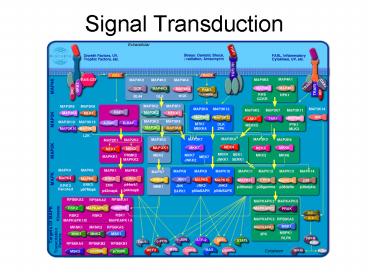Signal Transduction - PowerPoint PPT Presentation
1 / 17
Title:
Signal Transduction
Description:
Activated G proteins are short-lived because G also has GTPase activity (see ... Arg in Gs is ADP-ribosylated (from NAD ), activating adenylate cyclase. IV. ... – PowerPoint PPT presentation
Number of Views:26
Avg rating:3.0/5.0
Title: Signal Transduction
1
Signal Transduction
2
(No Transcript)
3
(No Transcript)
4
I. G Protein-Coupled Receptors(GPCRs)
- gt 1000 different mammalian GPCR genes
- 60 of drugs target GPCRs
- Membrane spanning domains consist of 7 helices
- Bind
- hormones (e.g, epinephrine)
- odorant molecules
- eicosanoids
- First to be characterized rhodopsin
5
(No Transcript)
6
II. Heterotrimeric G Proteins
- Bind GTP and GDP hydrolyze GTP to GDP Pi
- Consist of ?, ?, and ? subunits
- G? contains NT binding site in cleft
- G? and G? dissociate only under denaturing
conditions (G??) - Inactive state G? binds GDP (G??GDP-G??)
- Binding of GPCR to ligand causes exchange of GDP
for GTP in G protein G??GTP dissociates from G?? - Activated G proteins are short-lived because G?
also has GTPase activity (see cholera and
pertussin toxins) - Typical mammalian cell contains many different
combinations of subunits - Major target adenylate cyclase
- Some G proteins stimulate AC (Gs?)
- Some inhibit AC (GI?)
7
III. Adenylate CyclaseProduction of a SECOND
MESSENGER
- ATP ? cAMP PPi
8
(No Transcript)
9
(No Transcript)
10
(No Transcript)
11
Drugs/toxins increase cAMP
- Caffeine, theophylline, theobromine are agonists
for adenosine receptors
Cholera toxin binds to a membrane ganglioside,
allowing entry of toxic peptide fragment into
target cell. Arg in Gs? is ADP-ribosylated (from
NAD), activating adenylate cyclase.
12
IV. Receptor Tyr Kinases (RTKs)
- Insulin, growth factors act through RTKs
- Usually single transmembrane region
- Exist as monomers until ligand binds, then
proteins dimerize (except insulin) - Autophosphorylation of cytosolic Tyr-containing
domains - These poly-phosphorylated kinases then
phosphorylate other proteins - (There are many protein phosphatases that reverse
the cascades described)
13
(And some protein growth factors)
14
(No Transcript)
15
V. The Phosphoinositide Pathway
16
PI pathway, continued
- IP3 diffuses through cytosol to ER, where it
binds to a receptor, which is also an ion channel - Ca2, stored in the ER, is released, eliciting
wide-ranging cellular and extracellular responses
(muscle contraction, glucose mobilization) - DAG activates PKC, a cytosolic kinase
- When activated, PKC associates with membrane
- Many isoforms of PKC exist
17
Phorbol esters bind in a groove near the DAG
binding site.































